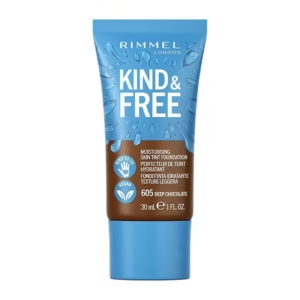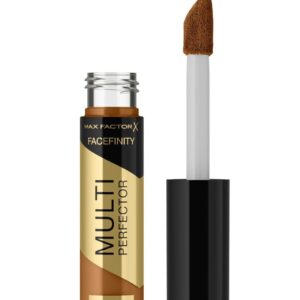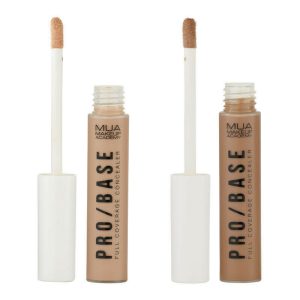
Finding the perfect foundation shade can feel like searching for a needle in a haystack, especially if you’re a beginner. Many people end up with a foundation that’s too light, too dark, or just doesn’t blend well with their skin, leaving them feeling frustrated.
The secret? It’s not just about picking a shade that looks close to your skin tone; it’s about understanding your undertone and choosing a formula that works for your skin type.
In Ghana’s hot and humid climate, it’s also important to choose a foundation that won’t feel too heavy, cakey, or melt off in the heat. In this guide, we’ll break down how to find your undertone, choose the right foundation shade, and select a formula that suits your skin type – so you can achieve a flawless, natural look every time.
Let’s get started!

Understanding Undertones – Warm, Cool, or Neutral?
Before you can find your perfect foundation match, you need to understand undertones. Your skin’s surface colour might change due to sun exposure, acne, or other factors, but your undertone stays the same, and that’s the key to choosing a foundation that looks natural.
What is an undertone?
An undertone is the subtle hue beneath your skin that determines how colours (like foundation, lipstick, and even clothing) look on you. It’s why a foundation that looks perfect in the bottle may appear ashy, orange, or dull on your skin – it’s not matching your undertone!
The Three Main Undertones
- Warm Undertones: Your skin has golden, yellow, or peachy hues.
- Cool Undertones: Your skin has pink, red, or bluish hues.
- Neutral Undertones: A mix of both warm and cool, more balanced.
How to Find Your Undertone (Easy Tests!)
1. The Vein Test
Look at the veins on your wrist in natural light:
- Green veins: You likely have a warm undertone.
- Blue or purple veins: You likely have a cool undertone.
- A mix of both: You likely have a neutral undertone.
2. The Jewellery Test
- Gold jewellery looks best on you: You’re warm-toned.
- Silver jewellery suits you better: You’re cool-toned.
- Both look equally good?: You’re neutral-toned.
3. The White vs. Off-White Test
- If bright white clothing makes your skin glow, you may have a cool undertone.
- If off-white or cream looks better on you, you likely have a warm undertone.
- If both work well, you probably have a neutral undertone.
How to Find Your Perfect Foundation Shade
Now that you’ve identified your undertone, it’s time to find a foundation shade that blends seamlessly into your skin. The right foundation should match your natural skin tone, even out your complexion, and disappear into your skin without looking too light or too dark.
Where to Test Your Foundation Shade
One of the biggest mistakes beginners make is testing foundation on their hands or wrists but these areas are often darker or lighter than your face. Instead, apply foundation on the following spots for the best match:
Jawline or Neck: This ensures a seamless transition between your face and neck.
Cheek Area: Helps match your shade where you apply the most product.
Natural Light Test: Always check in daylight to see how the foundation truly looks.
How to Choose the Right Shade Based on Your Undertone
Once you know your undertone, picking the right shade becomes easier:
- Warm Undertones: Look for shades labeled “golden,” “yellow,” or “warm beige.”
- Cool Undertones: Look for shades with “pink,” “rosy,” or “cool” in the name.
- Neutral Undertones: Look for shades with “neutral” or “beige” in the description.
Pro Tip: If your foundation looks grey or ashy, it’s too cool for your skin tone. If it looks orange, it’s too warm.
Mistakes to Avoid When Choosing a Foundation
- Going too light or too dark: A foundation that’s too light will make you look pale or ashy, while one that’s too dark may create a visible contrast between your face and neck.
- Not blending properly: Always blend well into your skin to ensure a natural finish.
- Skipping undertone matching: Just because a foundation looks right in the bottle doesn’t mean it will match your skin!
Now that we’ve found the perfect shade, let’s talk about something just as important – choosing the right foundation formula for your skin type!

Foundation and Skin Type – How to Find the Right Formula
Choosing the right foundation shade is important, but finding a formula that suits your skin type is just as crucial – especially in Ghana’s hot and humid climate. If you pick the wrong foundation formula, it can end up looking cakey, oily, or patchy throughout the day.
Let’s break down the best foundation types for different skin types so you can achieve a flawless, long-lasting finish!
Best Foundation Formulas for Different Skin Types
Oily Skin (Common in Ghana’s Humid Climate)
- Best foundation type: Matte, oil-free, powder, or long-wear liquid foundation.
- Why? These control excess oil and shine, keeping your makeup in place.
- Look for: Foundations labeled “matte,” “oil-free,” or “shine-control.”
- Avoid: Dewy or hydrating formulas – they can make your skin look extra greasy.
Dry Skin
- Best foundation type: Hydrating, dewy, or cream-based foundation.
- Why? These boost moisture and prevent flaking.
- Look for: Labels like “hydrating,” “luminous,” or “moisturising.”
- Avoid: Matte foundations, which can make your skin look dull and dry.
Combination Skin
- Best foundation type: Semi-matte or satin-finish liquid foundation.
- Why? These help balance oiliness in some areas (T-zone) while hydrating drier areas.
- Look for: “Semi-matte,” “natural finish,” or “balanced hydration.”
Sensitive Skin
- Best foundation type: Fragrance-free, hypoallergenic, and non-comedogenic formulas.
- Why? These are gentle on the skin and prevent irritation.
- Look for: “For sensitive skin,” “hypoallergenic,” or “dermatologist-tested.”
Tips for Long-Lasting Foundation in Hot & Humid Weather
- Use a primer: A mattifying or hydrating primer (depending on your skin type) will help your foundation stay put.
- Set with powder: Lightly dusting a translucent setting powder over your foundation prevents oiliness.
- Blot, don’t wipe: If you get oily throughout the day, use blotting paper or a tissue instead of wiping your makeup.
Now that we’ve covered shade matching and formula selection, let’s talk about choosing the right foundation shades for deeper skin tones, which is often a challenge in Ghana.
Shade Matching for Ghanaian Skin Tones
One of the biggest struggles when choosing foundation in Ghana is finding the right shade for deeper skin tones. Many brands don’t cater to the rich diversity of brown, deep, and ebony skin, leading to frustration when shades look ashy, too orange, or too red.
Here’s how to get the perfect match for your skin tone and undertone – without the struggle!
How to Choose the Right Foundation for Darker Skin
Look for brands with a wide shade range
- Opt for brands that cater to deep and dark skin tones, not just light to medium shades.
- Some popular brands with good deep shades: Fenty Beauty, Maybelline Fit Me, L’Oréal True Match, Black Opal, Juvia’s Place, and MAC Studio Fix.
Match your undertone
- Many people with deep skin tones have golden, olive, or neutral undertones, while others may have red undertones.
- If your foundation looks too grey, it may not have enough warmth.
- If it looks too red, try a neutral or golden undertone instead.
Mixing foundations for a custom match
- If you can’t find the perfect shade, try mixing two foundations – one slightly lighter and one slightly darker, to create a custom blend.
- You can also use a foundation adjuster (yellow, golden, or neutral mixers) to tweak your shade.
Test foundation in natural light
- Always check your foundation in sunlight or outdoor lighting to see if it blends well.
- Some foundations oxidise (get darker over time), so wait a few minutes after applying to see the true shade.
How to Apply Foundation for a Natural Look
Finding the perfect foundation shade and formula is only half the battle – how you apply it makes all the difference! The goal is to achieve a flawless, skin-like finish without looking cakey or heavy.
Here’s a step-by-step guide to applying foundation the right way, especially in Ghana’s hot and humid climate.
Step 1: Prep Your Skin for a Smooth Application
- Cleanse & Moisturise – A fresh, hydrated face helps foundation blend smoothly.
- Apply a primer –
- For oily skin: Use a mattifying primer to control shine.
- For dry skin: Use a hydrating primer to keep skin soft and supple.
Tip: Wait a few minutes for your skincare to absorb before applying foundation.
Step 2: Choose the Right Application Tool
Different tools give different finishes. Choose what works best for you!
- Makeup Sponge (Beauty Blender): Gives a natural, skin-like finish. Best for dry or combination skin.
- Foundation Brush: Provides more coverage and helps build up layers smoothly. Great for oily skin.
- Fingers: Works well for lightweight foundation or tinted moisturisers, but may not blend as seamlessly as a sponge or brush.
Step 3: Apply Foundation Like a Pro
- Start with a small amount: A little goes a long way! Add more if needed.
- Dot foundation on your face: Focus on the forehead, cheeks, nose, and chin.
- Blend outwards: Use a dabbing or stippling motion to blend, rather than rubbing.
- Blend into your neck & hairline: Avoid a harsh foundation line by blending downwards.
Step 4: Set Your Foundation for Long-Lasting Wear
- For oily skin: Set with loose or pressed powder to control shine.
- For dry skin: Use a light dusting of powder only in oily areas like the T-zone.
- For humid weather: Setting spray helps lock in foundation and prevent melting.
Bonus Tip: Less Is More!
Many beginners apply too much foundation, making it look heavy or unnatural. Instead:
- Use foundation to even out your skin tone.
- Use concealer for extra coverage on dark spots, under-eyes, or blemishes.
Finding the right foundation isn’t just about shade matching – it’s about choosing the right formula for your skin type and applying it correctly. With the right techniques, your foundation will look fresh, natural, and flawless all day long!
Ready to find your perfect foundation? Browse beginner-friendly foundation options at My Beauty Nook Ghana and start your makeup journey today!
Recommended products
-
Max Factor Facefinity All Day Flawless 3 in 1 Vegan Foundation
Original price was: ₵270.00.₵179.00Current price is: ₵179.00. -
MUA Pro-Base Long Wear Matte Finish Foundation
Original price was: ₵187.00.₵97.00Current price is: ₵97.00. -
Revlon Photoready Airbrush Effect Foundation
Original price was: ₵148.00.₵105.00Current price is: ₵105.00. -
Rimmel Kind & Free Moisturising Skin Tint Foundation – 30ml
Original price was: ₵175.00.₵138.00Current price is: ₵138.00. -
Rimmel Lasting Matte Liquid Foundation
Original price was: ₵250.00.₵124.00Current price is: ₵124.00. -
Rimmel Match Perfection Foundation
Original price was: ₵208.00.₵152.00Current price is: ₵152.00. -
Rimmel Lasting Finish 25H Hydration Boost Foundation
Original price was: ₵208.00.₵152.00Current price is: ₵152.00. -
Max Factor Facefinity Multi Perfector Concealer – 11ml
Original price was: ₵189.00.₵153.00Current price is: ₵153.00. -
MUA Pro-Base Full Coverage Concealer
Original price was: ₵99.00.₵70.00Current price is: ₵70.00.









One thought on “How to Choose the Right Foundation Shade for Your Undertone”